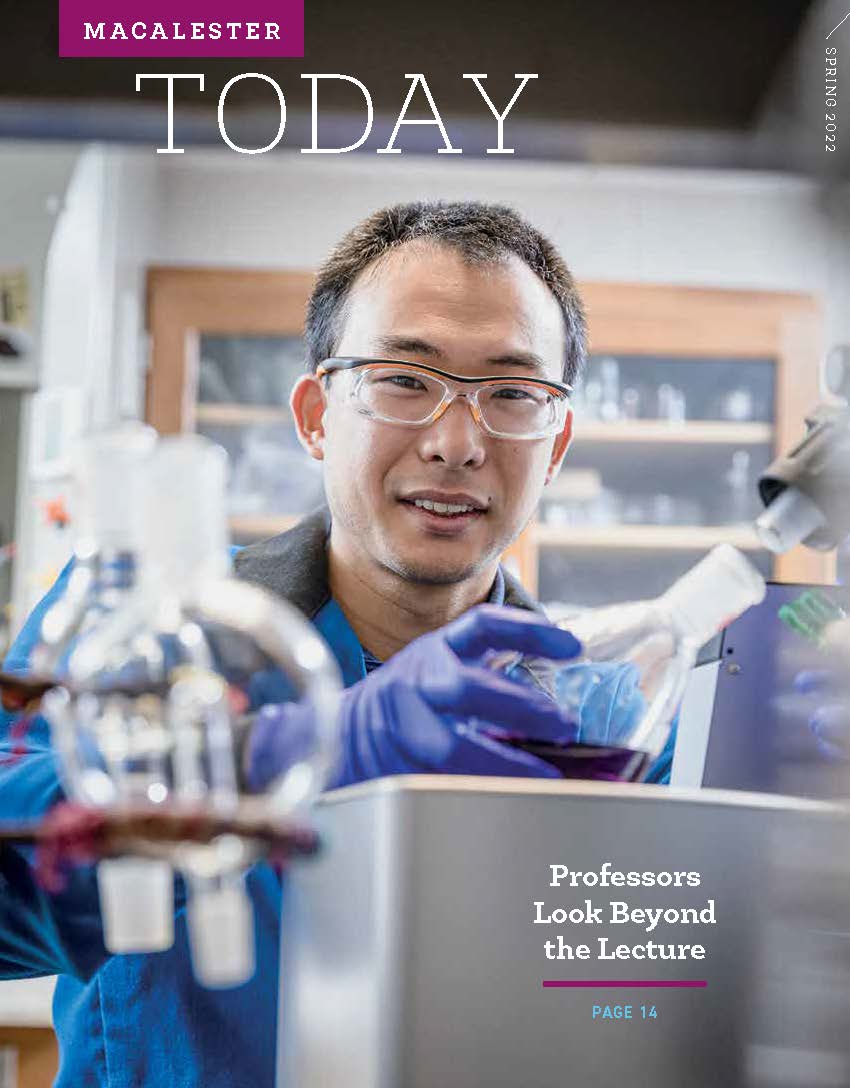
By Joe Linstroth / Illustration by Anna Takahashi
In an era when it often feels like people are looking at the same thing but coming to very different conclusions, having a better understanding of how our brains sense and perceive the world can be especially useful. In his class “Exploring Sensation and Perception,” Professor Eric Wiertelak, who is chair of the Psychology Department and a member of the Neuroscience faculty, takes an unconventional approach to examining how our brains make sense of the world around us. By using Japanese cuisine and the “pursuit of deliciousness” to explore our sense of taste, students learn not only about how others form their realities, but also how to better understand themselves.
Q: How is it that people’s perceptions of reality can be so different sometimes?
A: In psychology, the tendency to see the things that go along with what someone’s beliefs or expectations are is known as confirmation bias. If you spend most of your time in one place or with a particular group of people, you’re going to wind up having expectations that are based on those experiences. If you have more experience with people from all different walks of life, expectations are different. Our way of perceiving the world is the result of our combined experience across our lifespan. That’s how people can have very different perspectives on the same thing.
Q: What’s the neuroscience behind that?
A: That’s the organization of the brain itself. You start out as a baby with a basic neuromatrix that has everything connected to it. As you grow, connections either strengthen or get pruned off where it makes sense, given where you are in the world, what you’re born into. So if you’re born into a nomadic group in Mongolia and live in a ger, you’re going to have a different set of expectations that are valid for your nervous system compared to somebody who lives like we do in carpentered environments with lots of straight lines. The nervous system then comes to expect certain things about that environment. It’s painted onto the circuitry in our brains as to what is relevant to where you are.
Q: In your class, you explore this process through food. Why food?
A: It is not the traditional way to do a sensation and perception class; most often the sense of vision is used to provide focus in courses like this. Obviously vision is an incredibly important part of sensation and perception, but one of the interesting things about using flavors, taste, and food preferences—the pursuit of deliciousness— is that while everybody has to take in food, preferences vary by person. This allows students to be more introspective about their own personal experience, as well as learn about the processes of sensation and perception.
Q: What is it about Japanese cuisine in particular that makes it well suited to explore sensation and perception?
A: There’s a philosophy behind Japanese cuisine called washoku, which not only means the food of Japan, but harmony of flavors. It has to do with combinations of five items constantly repeating over and over again. The five different tastes, for example: salty, sweet, bitter, sour, and umami. Five different ways of preparing things, five different textures, multiple colors—meals are supposed to have these combinations in order to promote health and well-being. Rice, soup, three side dishes—it’s a nicely organized cuisine, and it’s delicious. We also draw focus on umami, a hallmark taste in Japanese cuisine, and investigate how that sensation correlates closely with the neurotransmitter glutamate.
Q: How does glutamate work in our brains?
A: Most people think the most important neurotransmitter is serotonin or dopamine, but there are others that you can think of as doing more of the nervous system’s heavy lifting. And for excitation—increasing the likelihood that connections are activated—glutamate is the most important neurotransmitter. Glutamate is a big part of what makes you sit up during a conversation and look at the person while you listen and nod. A large source of glutamate in American diets is parmesan cheese. And glutamate is the source of umami, which helps explain why our brains recognize it as a delicious taste.
The underlying purpose of having all these sensory apparatuses is to actually promote us as effective members of our species. And it’s really interesting to think of how the structure of the nervous system has put in reward mechanisms—neurochemical relationships such as our attraction to umami and glutamate—that give us great pleasure if we are achieving our ecological niche.
Q: How can we heighten our mind’s sensations of food?
A: Put away the cell phone and spend time enjoying your meal. Each time I teach this course, we make a class cookbook, and I put this concept on the cover: There is only this moment. If you allow a food experience to be what you’re about at that moment—and maybe care a bit more about the meal’s appearance or ritualize it in some way—it’s going to be more enjoyable. There’s a reason meals over candlelight and music have existed in romantic literature forever, because all the senses mark this as a special moment. And that’s really living, being in the moment.
Q: In pursuit of deliciousness, what can we learn about ourselves?
A: In terms of the visual aspects of something being delicious, or the sound or smell or taste, whatever combination resonates with us tells us about what kind of an individual we are. We are the things that we find delicious.
April 22 2022
Back to top





